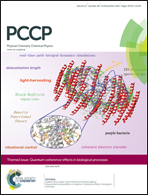Spatiotemporal dynamics of solvent-assisted lipid bilayer formation†
Abstract
The solvent-assisted lipid bilayer (SALB) method offers a general strategy to fabricate supported lipid bilayers on solid surfaces. In this method, lipids dissolved in alcohol are deposited on the target substrate in parallel with their aggregation during exchange with aqueous buffer solution which promotes spontaneous bilayer formation. Herein, a combination of experimental and theoretical approaches is employed in order to understand the key aspects of the SALB formation process. Epifluorescence microscopy experiments are conducted in order to measure the spatiotemporal dynamics of bilayer formation on a glass substrate in a microfluidic channel. Corresponding snapshots of bilayer formation at different stages are rationalized by a numerical simulation of solvent displacement inside the channel. Comparing simulation with experiment indicates that in close proximity to the side walls of the present setup, the bilayer formation is confined to a relatively thin region behind the moving solvent displacement front.


 Please wait while we load your content...
Please wait while we load your content...